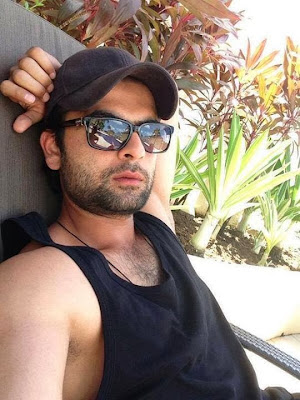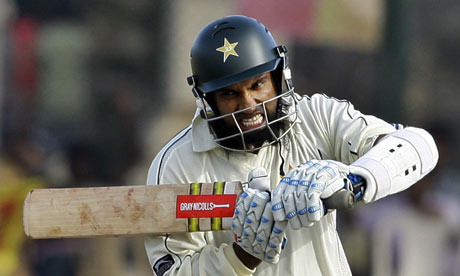source (google.com)
Full name Umar Akmal Born May 26, 1990, Lahore, Punjab Current age 20 years 238 days Batting style Right-hand bat Fielding position Occasional wicketkeeper Relation Brother – Kamran Akmal, Brother – Adnan Akmal Umar Akmal Picture Major teams Pakistan, Lahore...
Umar Akmal (born 26 May 1990 in Lahore) is a Pakistani cricketer. He made his ODI debut on August 1, 2009 against Sri Lanka.
Current age 20 years 238 days
Batting style Right-hand bat
Fielding position Occasional wicketkeeper
Relation Brother - Kamran Akmal, Brother - Adnan Akmal
Playing Roll: Batsman
Batting Style: Right
The runs didn't cease to flow
for Umar Akmal, the younger brother of Pakistan wicketkeeper Kamran and
Adnan, in his maiden first-class season. In a triumphant 2007-08 for Sui
Northern Gas Pipelines Limited, Umar failed to score in his first
outing but then went on to amass 855 runs from nine matches in the
Quaid-e-Azam Trophy, at an average of 77.72 and an impressive
strike-rate of 90.18. He showed a penchant for both brisk and big
scoring, with knocks of 248 off 225 balls and 186 off 170. In January
2008, he was picked in Pakistan's Under-19 team for the World Cup in
Malaysia. He was the leading run-getter - with 255 runs at a strike-rate
of 123.18 - in a tri-nation tournament involving England and Sri Lanka
in the lead-up to the World Cup. A successful tour of Australia with
Pakistan A was followed up a maiden international call-up for the ODIs
in Sri Lanka, and Umar started off with a half-century in his second
game and a power-packed hundred in his third. A Test call-up was
inevitable and he gave an optimistic glimpse into the future of Pakistan
cricket, with a century on debut, under pressure followed by a string
of consistent scores in New Zealand.
As
explosive starts to one’s International careers go, few can rival Umar
Akmal. He announced his entry with scores of 66 and 102* within his
first 3 ODI innings (at Sri Lanka, 2009) in addition to a 129 and 75 on
Test debut (at New Zealand, 2009). Those performances weren’t a
surprise. At first class level, Akmal was renowned for his big scores
amassed in quick time. 7 years prior to his debut, Umar’s elder brother
Kamran had already gotten his taste of international cricket. By 2010,
the siblings featured regularly, in tandem for Pakistan.
As
a fearless, middle-order batsman, throughout Pakistan’s disappointing
spree of series losses against Sri Lanka in 2009 and later at Australia
in early 2010, Umar Akmal’s ascendance was one of their few positives.
But as the series in Australia progressed, complacency began to creep
into Akmal’s Test form, which started to dip. In ODIs though, a hundred
and five fifties by his 18th outing maintained a steady average. It was
enough to justify an inclusion in Pakistan’s 2010 T20 World Cup squad.
He finished the tournament as Pakistan’s 3rd highest-run getter towards
their semi-final run.
While still
protected as a batsman, featuring at 3-down, in a Pakistan side that
lacks specialist batsmen with the temperament for all forms of the game,
Umar Akmal is their most proven rookie to fill the void for the years
to come.
The runs didn't cease to
flow for Umar Akmal, the younger brother of Pakistan wicketkeeper
Kamran and Adnan, in his maiden first-class season. In a triumphant
2007-08 for Sui Northern Gas Pipelines Limited, Umar failed to score in
his first outing but then went on to amass 855 runs from nine matches in
the Quaid-e-Azam Trophy, at an average of 77.72 and an impressive
strike-rate of 90.18. He showed a penchant for both brisk and big
scoring, with knocks of 248 off 225 balls and 186 off 170. In January
2008, he was picked in Pakistan's Under-19 team for the World Cup in
Malaysia. He was the leading run-getter - with 255 runs at a strike-rate
of 123.18 - in a tri-nation tournament involving England and Sri Lanka
in the lead-up to the World Cup. A successful tour of Australia with
Pakistan A was followed up a maiden international call-up for the ODIs
in Sri Lanka, and Umar started off with a half-century in his second
game and a power-packed hundred in his third. A Test call-up was
inevitable and he gave an optimistic glimpse into the future of Pakistan
cricket, with a century on debut, under pressure followed by a string
of consistent scores in New Zealand.
Batting and fielding averages
Mat Inns NO Runs HS Ave BF SR 100 50 4s 6s Ct St
Tests 15 29 2 988 129 36.59 1481 66.71 1 6 115 17 12 0
ODIs 43 39 6 1249 102* 37.84 1430 87.34 1 8 98 21 18 0
T20Is 22 21 3 571 64 31.72 474 120.46 0 4 41 18 18 1
First-class 46 79 7 3346 248 46.47 4652 71.92 7 20 410 53 41 0
List A 68 63 9 2012 104 37.25 2298 87.55 3 12 150 38 32 0
Twenty20 46 43 8 1114 68* 31.82 861 129.38 0 7 107 30 35 1
Bowling averages
Mat Inns Balls Runs Wkts BBI BBM Ave Econ SR 4w 5w 10
Tests 15 - - - - - - - - - - - -
ODIs 43 - - - - - - - - - - - -
T20Is 22 - - - - - - - - - - - -
First-class 46 1 6 10 0 - - - 10.00 - 0 0 0
List A 68 2 24 13 0 - - - 3.25 - 0 0 0
Twenty20 46 1 24 36 1 1/36 1/36 36.00 9.00 24.0 0 0 0
Fast Facts
Akmal’s total of 204 runs on his Test debut (against New Zealand) is the 8th highest ever.
It’s also the second highest for a Pakistani debutant behind Yasir Hameed’s 275 in 2003.
Umar Akmal
Umar Akmal
Umar Akmal
Umar Akmal
Umar Akmal
Umar Akmal
Umar Akmal
Umar Akmal
Umar Akmal
Umar Akmal
Umar Akmal

























